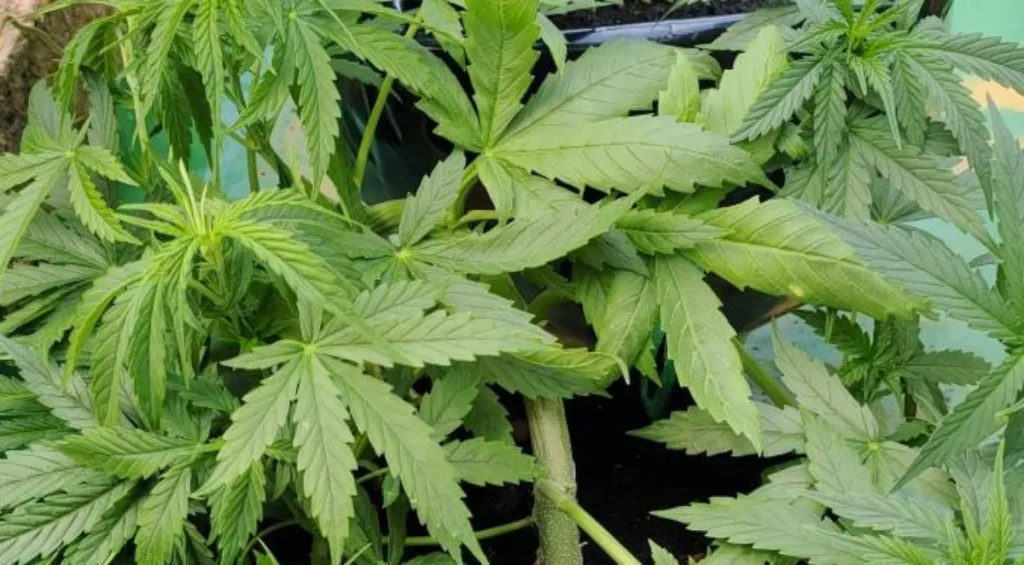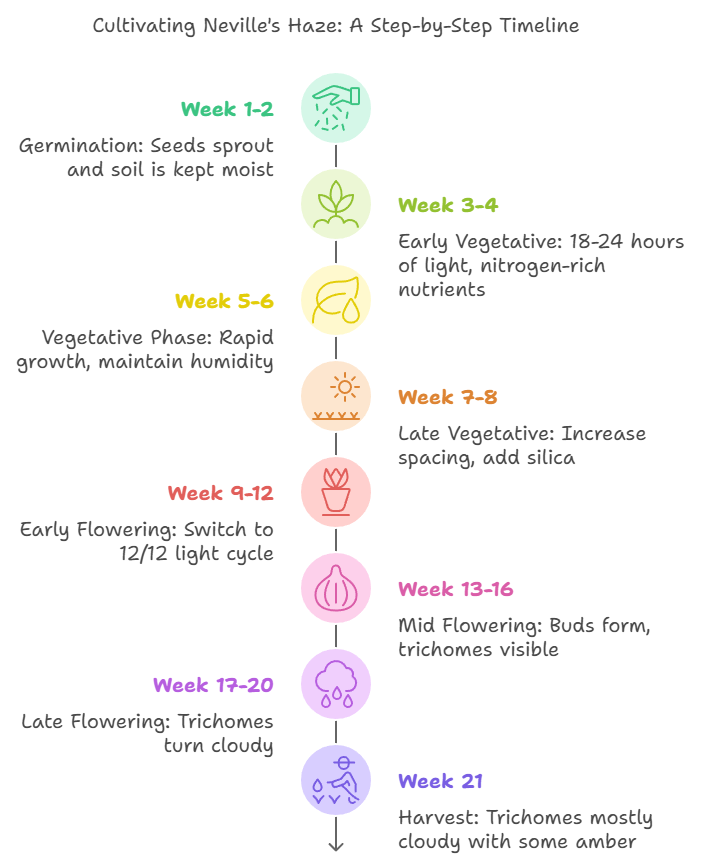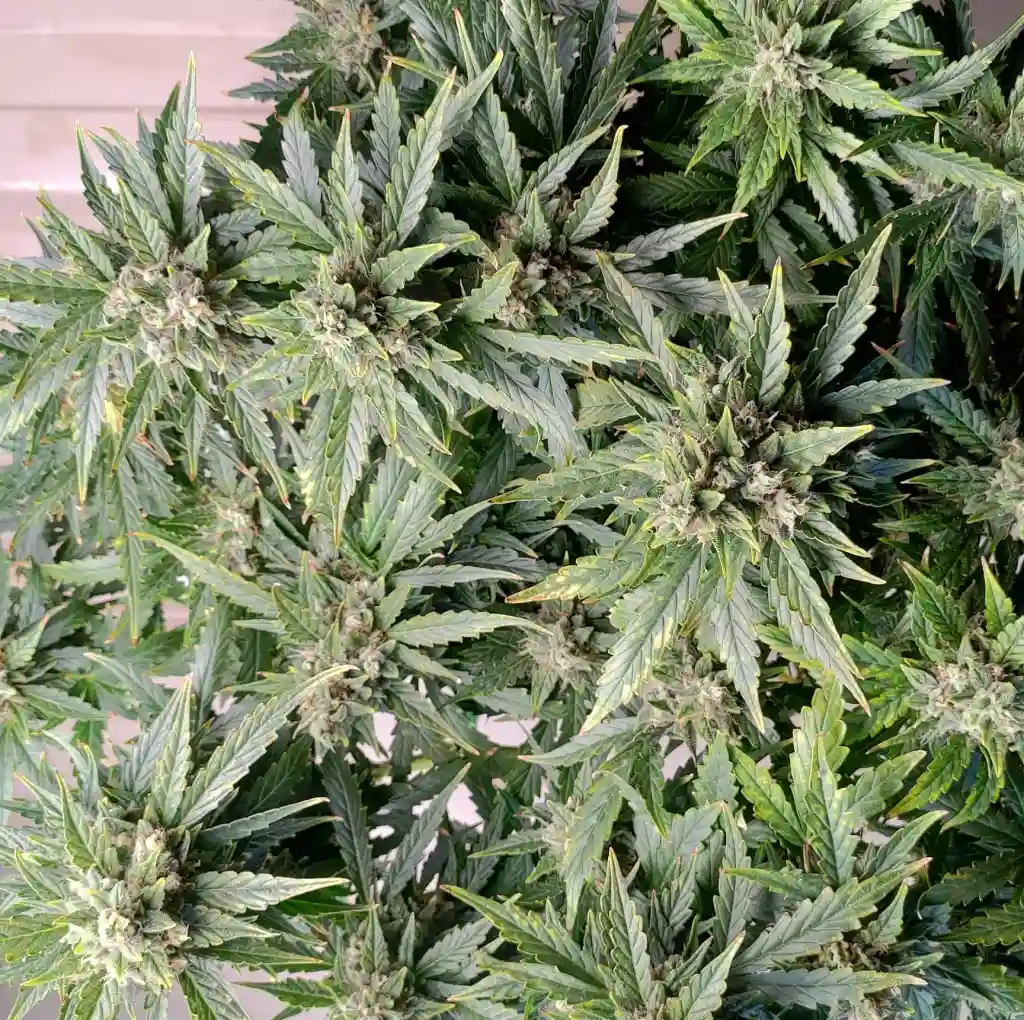Neville’s Haze Strain Description
Neville’s Haze Strain is a sativa-dominant variety celebrated for its potent, cerebral high and high THC levels. With lineage from Haze and Northern Lights, it offers a distinctive blend of pine, citrus, and earthy notes. This strain delivers long-lasting, uplifting effects, making it ideal for daytime use and creative pursuits. Its strong energizing properties and complex flavor profile make it a favorite among enthusiasts. Cultivating Neville’s Haze Strain requires skill and attention to detail due to its growth demands, but the results are highly rewarding for dedicated growers.
Neville’s Haze Strain’s tall structure and robust genetics make it a challenging yet worthwhile endeavor for cultivators. It thrives in environments with ample space and consistent care. For users, its long-lasting effects, paired with its unique terpene profile, offer an unparalleled experience. While it demands more effort than other strains, its high yields, potency, and exceptional flavors make it a staple for growers seeking premium results.
Environmental Requirements for Growing Neville’s Haze Strain
Neville’s Haze Strain flourishes in warm, tropical-like conditions. Optimal temperatures range from 75 to 85°F, with humidity levels of 60-70% during the vegetative phase. This should drop to 40-50% during flowering to avoid mold. Its preference for well-aerated environments makes air circulation critical. Proper airflow prevents moisture buildup and supports healthy development. Given its significant vertical growth, providing ample space is vital for its vigorous structure.
This strain’s sensitivity to environmental shifts requires growers to maintain stable conditions. Regular monitoring of temperature, humidity, and airflow ensures healthy plants and maximizes yields. Indoor setups benefit from controlled environments, while outdoor cultivation thrives in regions with consistent sunlight and long growing seasons. Adapting to its specific needs results in higher quality buds and improved overall plant health.
Setting Up the Growing Cannabis Space
A proper grow space for Neville’s Haze Strain should ensure maximum light exposure and airflow. Indoors, LED grow lights are ideal for replicating natural sunlight. Reflective materials like Mylar enhance light distribution, while dehumidifiers maintain ideal moisture levels. Outdoor growers should choose nutrient-rich soil and spacious planting areas to support its height. Good spacing reduces mold risks and allows better airflow around the plants.
This strain’s vigorous growth benefits from structured environments. Using training techniques like topping or low-stress training (LST) ensures even canopy development and height management. These methods optimize light penetration and improve bud production. For outdoor cultivation, selecting a location with ample sunlight and wind exposure is crucial. Proper preparation and consistent monitoring enhance plant health and yield quality.
Indoor Cannabis Cultivation
Indoor growers should provide at least 18-24 hours of strong light during the vegetative phase. High ceilings accommodate its tall structure, and temperature control ensures optimal growth. Using LED lights and reflective materials helps maximize light absorption. Indoor humidity must be adjusted to prevent mold during flowering. Techniques like topping and pruning are essential for managing height and creating uniform canopies.
Temperature stability and precise humidity control are key indoors. Neville’s Haze Strain requires consistent attention to airflow and spacing, especially during flowering. Dehumidifiers and fans help maintain ideal conditions. By mimicking natural environments, indoor growers can achieve the strain’s full potential, yielding dense, aromatic buds with excellent potency.
Outdoor Cannabis Cultivation
Outdoor cultivation of Neville’s Haze Strain thrives in Mediterranean-like climates with long, sunny seasons. Its extensive root system benefits from nutrient-dense soil, promoting strong, vigorous growth. Adequate spacing is necessary to prevent overcrowding and support healthy airflow. Regular pruning reduces the risk of mold in regions with fluctuating humidity.
Outdoor growers must remain vigilant against pests and mold. This strain’s height and dense buds require consistent care to ensure optimal health. Monitoring environmental changes and adapting nutrient schedules boost yields. When grown in ideal conditions, Neville’s Haze Strain produces impressive, resin-rich flowers that showcase its premium genetics.
Propagation and Germination of Neville’s Haze Strain
Propagation of Neville’s Haze Strain can be done using seeds or clones. Seeds provide genetic diversity, while clones ensure consistency. Soaking seeds for 24 hours before planting promotes germination. Germinated seeds need warm, moist conditions to sprout successfully. Using a grow light for 18-24 hours daily supports early-stage growth.
During germination, maintaining stable temperatures and consistent moisture is critical. Neville’s Haze Strain thrives when seedlings are nurtured with care. Clones offer a quicker start but require attention to rooting conditions. Whether using seeds or clones, creating an optimal environment ensures strong initial growth and a robust vegetative phase.
Vegetative Phase of Neville’s Haze Strain
During the vegetative phase, Neville’s Haze Strain requires 18+ hours of light daily. This supports its rapid growth and prepares the plant for a productive flowering stage. Nitrogen-rich nutrients are essential during this phase to sustain vigorous development. Weekly feedings ensure consistent nutrient availability.
Training techniques like topping or LST help manage the plant’s height and encourage even canopy development. These methods improve light penetration and maximize potential yields. Maintaining a soil or nutrient solution pH between 6.0-6.5 ensures optimal nutrient absorption. Proper care during this phase sets the foundation for a successful harvest.
Flowering Phase of Neville’s Haze Strain
Neville’s Haze Strain has a longer flowering period of 12-14 weeks. A 12/12 light cycle triggers bud production, and humidity levels should gradually decrease to 40-45% during this stage. Strong airflow is essential to prevent mold on the dense, aromatic buds. Balanced bloom fertilizers enhance bud development and terpene production.
As flowering progresses, regular inspections ensure healthy growth. Avoid overwatering or overfeeding, as this can stress the plant. Trichome monitoring helps determine harvest readiness, ensuring peak potency. Proper management during flowering results in resin-rich, flavorful buds that highlight the strain’s superior genetics.
Cannabis Fertilization and Nutrition
Neville’s Haze Strain demands nutrient-rich soil or hydroponic solutions. During vegetative growth, nitrogen is crucial for leafy development. In flowering, phosphorus and potassium promote bud formation. Micronutrients like calcium and magnesium support overall plant health and prevent deficiencies.
Monitoring nutrient levels and adjusting schedules prevents overfeeding, which can lead to nutrient burn. Regular pH checks ensure proper nutrient uptake. Whether grown in soil or hydroponics, balanced feeding practices maximize yields and enhance bud quality. Proper nutrition is key to achieving the strain’s full potential.
Pest and Disease Control for Cannabis Growing
Prevention
Preventive measures like neem oil sprays and beneficial insects protect Neville’s Haze Strain from pests. Regular inspections of leaves and stems help detect issues early. Proper airflow reduces humidity-related risks, minimizing mold and mildew occurrences.
Corrective Actions
Quick action is vital if pests or diseases are detected. Sticky traps capture flying insects, and insecticidal soaps manage infestations. Mold-affected areas should be removed immediately to prevent spread. Consistent monitoring and intervention ensure healthy plants and optimal harvests.
Harvesting and Curing Neville’s Haze Strain
Neville’s Haze Strain reaches its peak harvest time when the trichomes are mostly milky with a few amber ones appearing. This balance ensures a potent product with its signature energetic and cerebral effects intact. Harvesting too early can result in weaker potency, while waiting too long may diminish the uplifting high. Regularly inspect trichomes using a magnifying tool to pinpoint the ideal harvest window.
After harvest, buds should be carefully trimmed and hung in a dark, cool space with excellent airflow to dry. Maintaining a temperature of 60-70°F and a relative humidity of 50-60% during drying prevents mold and preserves the strain’s terpene profile. Once the buds are dry, they should be transferred to airtight glass jars for curing. Opening the jars daily during the first week releases excess moisture and allows proper curing. Over several weeks, this process enhances Neville’s Haze Strain’s rich flavors, smoothens the smoke, and boosts overall quality, making it a standout choice for consumers.

Is Neville’s Haze Strain Indica or Sativa?
Neville’s Haze Strain is a predominantly sativa strain known for its invigorating, cerebral effects. Its high THC content delivers an energetic and uplifting experience, ideal for creative activities and daytime use. The sativa dominance also influences its physical characteristics, including its tall, slender stature and prolonged flowering period, making it a favorite among growers and users seeking an energizing cannabis experience.
Its genetic lineage, tracing back to Haze and Northern Lights, underscores its sativa attributes while adding complexity to its effects and flavor. This balance makes Neville’s Haze Strain a standout option for those looking to stay motivated and focused.
Advantages of Growing Neville’s Haze Strain
Growing Neville’s Haze Strain offers numerous benefits. Its high THC levels provide a potent harvest, making it a favorite among cannabis enthusiasts. The unique flavor profile, combining citrus, pine, and earthy undertones, sets it apart from other strains. Additionally, its resin-rich buds yield high-quality cannabis suitable for various uses, including concentrates and smoking.
Another advantage is its natural resistance to common pests, reducing the need for heavy chemical interventions. For experienced growers, the challenge of cultivating Neville’s Haze Strain is rewarding, as it produces generous yields when its specific needs are met, showcasing its superior genetics.
Disadvantages of Growing Neville’s Haze Strain
Despite its benefits, growing Neville’s Haze Strain has challenges. Its extended flowering time, often lasting 12-14 weeks, can deter growers seeking faster results. The strain’s significant vertical growth requires substantial space, making it less suitable for compact indoor setups. Managing its height can be labor-intensive and necessitates training techniques.
Humidity control is another critical factor, as its dense buds are prone to mold if moisture levels are too high. Growers need to maintain consistent airflow and monitor humidity closely to prevent issues. These factors make it more suitable for experienced cultivators prepared to invest time and effort.
Problems in Cultivating Neville’s Haze Strain
One of the primary issues in cultivating Neville’s Haze Strain is its susceptibility to nutrient deficiencies if the feeding schedule is not carefully balanced. Overfeeding can lead to nutrient lockout, while underfeeding may stunt growth. Monitoring pH levels and nutrient uptake is crucial to prevent problems.
Mold poses another risk due to the strain’s dense bud structure. Inadequate airflow or high humidity levels can encourage mold growth, potentially ruining a harvest. Pests like spider mites are also a concern, particularly in warm indoor environments. Regular inspections and preventive measures are vital to maintaining healthy plants.
Advanced Pest Control for Cannabis Growing
For advanced pest control, integrated pest management (IPM) techniques are highly effective. Combining biological controls like predatory insects with physical barriers such as mesh screens helps reduce pest populations naturally. Organic sprays, including neem oil, can be used as preventive measures without harming the plant.
Regular monitoring is crucial for identifying pest issues early. Employing yellow sticky traps for flying insects and using beneficial nematodes for soil pests are additional steps to maintain a healthy grow environment. These methods ensure pests are managed sustainably, preserving plant quality and yields.
Similar Strains
If you enjoy Neville’s Haze Strain, consider exploring similar sativa-dominant options. Super Silver Haze shares uplifting effects and a comparable genetic lineage. Arjan’s Ultra Haze #1 offers extended flowering and cerebral highs, while Amnesia Haze Auto provides a faster-flowering alternative with similar flavor notes and effects.
These strains complement Neville’s Haze Strain’s characteristics, offering a range of options for sativa enthusiasts seeking energetic and creative experiences.
Week-by-Week Growth Plan for Neville’s Haze Strain
Week 1-2 (Germination)
Start by soaking Neville’s Haze seeds in water for 12-24 hours until they sprout. Transfer sprouted seeds to moist, nutrient-free soil or a seed starter mix. Maintain temperatures between 75-80°F (24-27°C) and keep humidity at around 70%. Use gentle, low-intensity lighting to avoid stressing the delicate seedlings. Check daily to ensure the soil remains moist but not waterlogged.
Healthy seedlings should emerge with two small cotyledon leaves. At this stage, focus on providing stable environmental conditions to encourage strong root development and steady growth.
Week 3-4 (Early Vegetative)
Transition the seedlings into larger pots to provide ample room for root expansion. Increase light exposure to 18-24 hours daily, using LED grow lights to deliver consistent energy. Begin feeding a nitrogen-rich nutrient solution at low concentrations to promote strong vegetative growth. Humidity should be maintained at 60-70%, with temperatures around 72-82°F (22-28°C).
Implement low-stress training (LST) techniques during this stage to gently shape the plant and control its height. Regularly inspect the plants for signs of pests or nutrient deficiencies and adjust care accordingly.
Week 5-6 (Vegetative Phase)
Neville’s Haze enters a vigorous growth phase, characterized by significant foliage development. Maintain an 18/6 light cycle and continue using nitrogen-dominant fertilizers to support robust leaf and stem growth. Increase ventilation to ensure proper airflow, reducing the risk of mold and mildew.
Humidity should stay within the 60-65% range, and temperatures should remain steady at 72-82°F (22-28°C). If the plant exhibits rapid upward growth, consider topping or applying additional LST to manage height and encourage lateral bud site development.
Week 7-8 (Late Vegetative)
As Neville’s Haze grows taller, space the plants further apart to allow for better airflow and light penetration. This stage is ideal for adding silica supplements to strengthen the stems and prepare the plant for the heavy buds that will form during flowering. Gradually lower humidity to around 50-55% to prevent moisture-related issues.
Start preparing for the flowering phase by gently transitioning the plants to a 12/12 light schedule. Ensure the plants are healthy and free of pests or diseases before entering the flowering stage.
Week 9-12 (Early Flowering)
Switch to a 12/12 light cycle to trigger flowering. Introduce phosphorus-heavy bloom nutrients to support bud formation and reduce humidity to below 50%. Maintain temperatures between 68-78°F (20-25°C) to optimize growth. Neville’s Haze will begin producing small flowers during this phase, which will gradually develop into dense buds.
Monitor plants daily for signs of nutrient deficiencies, pest infestations, or other stress factors. Strong airflow is essential during this phase to prevent mold growth on forming buds.
Week 13-16 (Mid Flowering)
Buds become larger and start to develop resin and terpenes, contributing to Neville’s Haze’s distinct aroma and flavor. Continue feeding phosphorus-rich nutrients and consider adding potassium supplements to further enhance bud density. Keep humidity levels low (40-50%) to reduce the risk of mold or bud rot.
Support heavy branches with stakes or trellises to prevent breakage. During this stage, you may notice a significant increase in the plant’s aroma, so consider using car

FAQs About Neville’s Haze Strain
What is the THC percentage of Neville’s Haze Strain?
Neville’s Haze Strain typically boasts a THC content ranging from 18-22%, offering a potent and long-lasting high. This level of THC makes it a favorite among experienced users who appreciate a strong, cerebral effect. The high THC content provides an uplifting and energetic buzz, making it ideal for daytime use or creative activities. However, novice users should approach this strain with caution due to its intensity.
How long does it take for Neville’s Haze Strain to flower?
Neville’s Haze has a longer-than-average flowering time, taking approximately 12-14 weeks to reach full maturity. This extended growth period is a characteristic of its Sativa lineage and is crucial for developing the strain’s unique flavor profile and potent effects.
What flavors and terpenes are present in Neville’s Haze Strain?
Neville’s Haze features a complex flavor profile with prominent pine, citrus, and earthy notes. These flavors are attributed to its rich terpene profile, including myrcene, known for its earthy and musky undertones; pinene, which delivers a refreshing pine scent; and limonene, contributing a zesty citrus twist.
Can Neville’s Haze Strain be grown both indoors and outdoors?
Yes, Neville’s Haze can thrive in both indoor and outdoor environments. Indoor growers must account for its height, as this strain can grow tall due to its Sativa dominance. High ceilings and techniques like topping or low-stress training (LST) are essential to manage its vertical growth effectively.
What are the medicinal benefits of Neville’s Haze Strain?
Neville’s Haze offers a variety of medicinal benefits, making it a popular choice among medical cannabis users. Its uplifting effects are ideal for relieving stress and combating fatigue, providing users with a burst of energy and mental clarity. These qualities make it particularly effective for managing symptoms of depression and anxiety.

